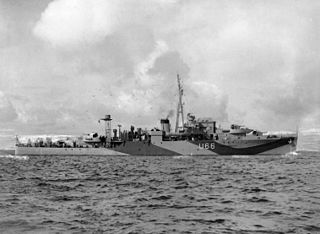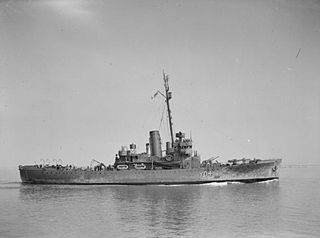
The Henschel Hs 293 was a World War II German radio-guided glide bomb. It is the first operational anti-shipping missile, first used unsuccessfully on 25 August 1943 and then with increasing success over the next year, ultimately damaging or sinking at least 25 ships. Allied efforts to jam the radio control link were increasingly successful despite German efforts to counter them. The weapon remained in use through 1944 when it was also used as an air-to-ground weapon to attack bridges to prevent the Allied breakout after D-Day, but proved almost useless in this role.

HMS Black Swan, was the name ship of the Black Swan-class sloops of the Royal Navy. This class was admired for its sea-going qualities.

HMS Starling, pennant number U66, was a Modified Black Swan-class sloop of the Royal Navy. She was active in the Battle of the Atlantic during the Second World War and was the most successful anti-submarine warfare vessel of the Royal Navy, being credited with the destruction of fourteen U-boats.

HMS Malcolm was one of eight Admiralty-type destroyer leaders built for the Royal Navy during World War I. She was the first of only two Royal Navy ships to carry the name Malcolm, although HMS Valkyrie was originally planned to bear the name. She was one of two Admiralty-type leaders to miss the First World War but saw service in, and survived, the Second World War. Her pennant number was changed from D19 to I19 in May 1940. She was broken up in 1945.

HMS Duckworth (K351) was a Captain-class frigate of the Royal Navy. She served during the Second World War as a convoy escort and anti-submarine warfare vessel in the Battle of the Atlantic and was an effective U-boat killer, being credited with the destruction of five U-boats during the conflict.

The Banff-class sloop was a group of ten warships of the Royal Navy. Built as United States Coast Guard Lake-class cutters, in 1941 these ships were loaned to the Royal Navy as antisubmarine warfare escort ships. The transfers took place at the Brooklyn Navy Yard; the sloops were manned for transport to Britain by personnel from the damaged battleship Malaya which was under repair there.

The Egret-class sloops were a three ship class of a long-range escort vessels used in the Second World War by the Royal Navy. They were an enlarged version of the Bittern class with an extra twin 4-inch gun mounting. They were fitted with Denny Brown stabilisers and the Fuze Keeping Clock anti-aircraft fire control system.
The 2nd Escort Group was a British anti-submarine formation of the Royal Navy which saw action during the Second World War, principally in the Battle of the Atlantic.
36th Escort Group was a British formation of the Royal Navy which saw action during the Second World War, principally in the Battle of the Atlantic. The group operated mainly on the Gibraltar and South Atlantic convoy routes and was involved in several convoy battles, including Convoy HG 76, one of the first Allied victories in the Atlantic campaign.
Convoys SL 138/MKS 28 were two Allied convoys which ran during the Battle of the Atlantic in World War II. SL 138 was one of the SL convoys from the South Atlantic to Britain, and MKS 28 one of the MKS convoys between Britain and the Mediterranean. They were sailing together on the Gibraltar homeward route, having made a rendezvous off Gibraltar in order to cross the Bay of Biscay with the maximum possible escort. They were the subject of a major U-boat attack in October 1943, the first battle in the Kriegsmarine's renewed Autumn offensive.
Convoys SL 139/MKS 30 were two Allied convoys which ran during the Battle of the Atlantic in World War II. SL 139 was one of the SL convoys from the South Atlantic to Britain, and MKS 30 one of the MKS convoys between Britain and the Mediterranean. They were sailing together on the Gibraltar homeward route, having made a rendezvous off Gibraltar in November 1943. They were the subject of a major U-boat attack, as part of the Kriegsmarine's renewed Autumn offensive.

HMS Bideford was a Royal Navy Shoreham-class sloop. She was named after the town of Bideford in Devon and was launched on 1 April 1931.

HMS Vetch (K132) was a Flower-class corvette that served in the Royal Navy during the Second World War. After helping to escort many convoys and sinking two U-boats, she was decommissioned and sold in 1945.

HMS Stork (L81) was a Bittern-class sloop of the Royal Navy. She was active during the Second World War, serving in convoy escort groups, and was a successful anti-submarine warfare vessel, being credited with the destruction of four U-boats.

HMS Pelican (L86) was an Egret-class sloop, built for the British Royal Navy. She was active during the Second World War and was a successful anti-submarine warfare vessel, being credited with the destruction of four U-boats.

HMS Rochester (L50) was a Shoreham-class sloop of the Royal Navy. She served during the Second World War and was a successful anti-submarine warfare vessel, being credited with the destruction of five U-boats.

Clive Gwinner (1908–1998) was a Royal Navy officer who served during the Second World War. He was a successful Anti-Submarine Warfare commander, being credited with the destruction of seven U-boats during the Battle of the Atlantic.

The Gibraltar convoys of World War II were oceangoing trade convoys of merchant ships sailing between Gibraltar and the United Kingdom. Gibraltar convoy routes crossed U-boat transit routes from French Atlantic ports and were within range of Axis maritime patrol aircraft making these convoys vulnerable to observation and interception by bombers, submarines, and surface warships during the Battle of the Atlantic. OG convoys brought supplies from the United Kingdom to Gibraltar from September 1939 until September 1942. Beginning with Operation Torch, OG convoys were replaced by KM convoys transporting military personnel and supplies from the United Kingdom to and past Gibraltar into the Mediterranean Sea. HG convoys brought food, raw materials, and later empty ships from Gibraltar to the United Kingdom from September 1939 until September 1942. After Operation Torch, HG convoys were replaced by MK convoys returning mostly empty ships from the Mediterranean to the United Kingdom. KM and MK convoys ended in 1945.

HMS Fleetwood was a Grimsby-class sloop of the Royal Navy. Built at Devonport Dockyard in the 1930s, Fleetwood was launched in March 1936 and commissioned in November that year. She served in the Red Sea until the outbreak of the Second World War. Fleetwood served as a convoy escort during the war, which she survived, and sank the German submarines U-528 and U-340. Post-war, the ship served as a radar training ship, remaining in use until 1959, when she was scrapped.

HMS Dart (K21) was a River-class frigate of the Royal Navy. Dart was built to the RN's specifications as a Group I River-class frigate.















